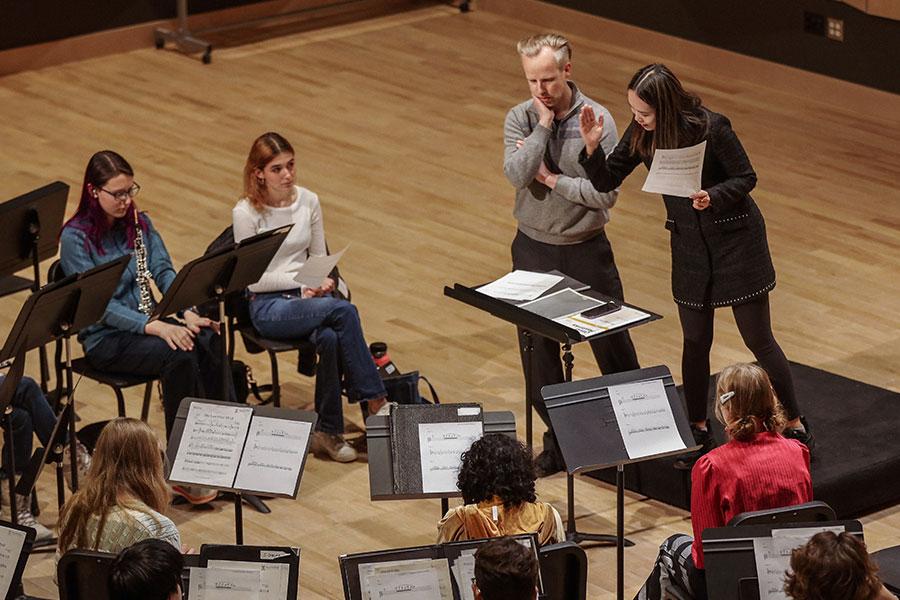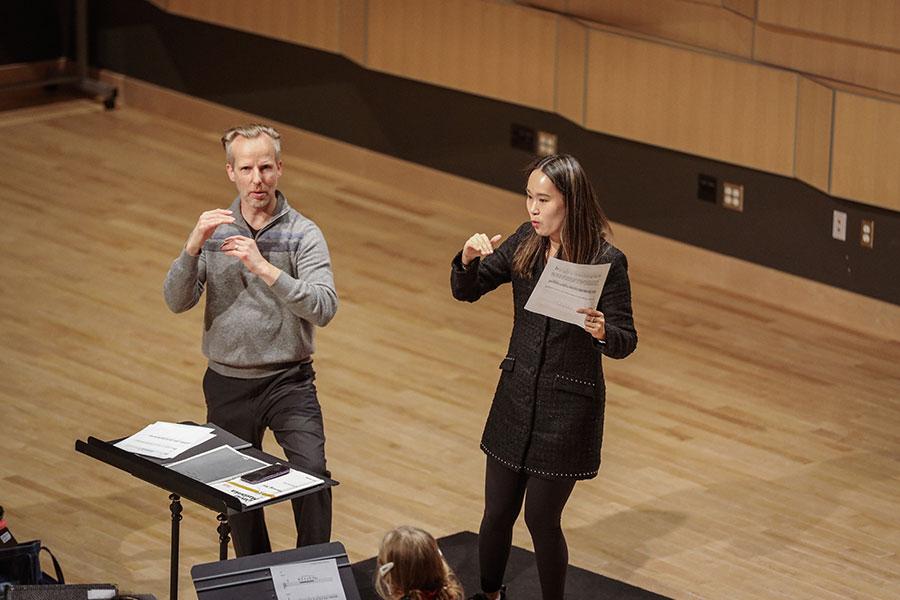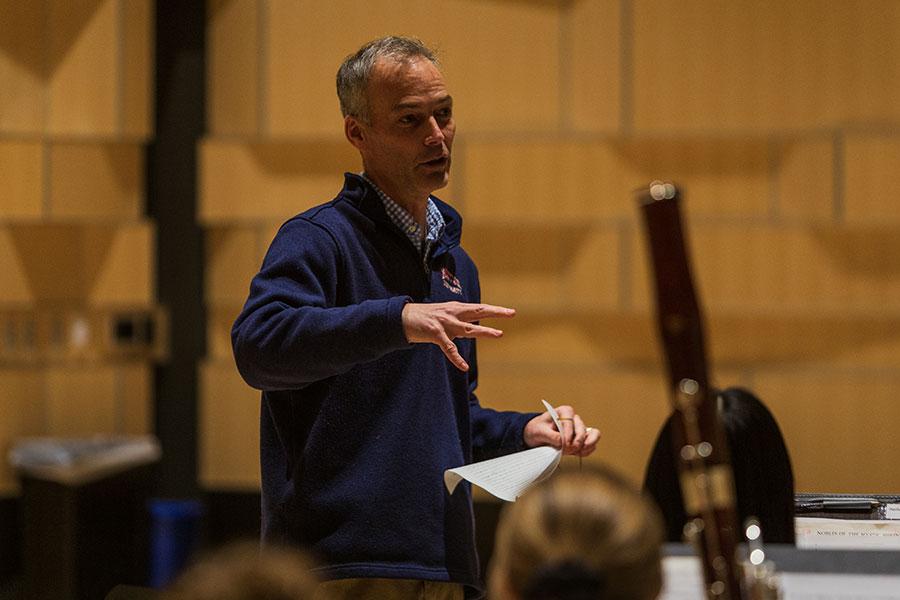'A resource for composers': Composer’s Sandbox builds on tradition of innovation and inspiration
Inspired by Interlochen’s long history with acclaimed composers, the creative residency offers composers the freedom and resources needed to explore new musical ideas.
In 1928, Interlochen Center for the Arts founder Joseph Maddy invited composer and educator Howard Hanson to serve as a guest artist for the inaugural season of the National High School Orchestra Camp.
While Hanson’s assignment was to conduct the National High School Orchestra, he spent a significant portion of his visit composing his second symphony—including the tranquil melody now known as “The Interlochen Theme.” The excerpt has served as the closing number of all Interlochen Arts Camp concerts for generations.
Although Hanson was the first acclaimed composer to be inspired by the people and places of Interlochen, he was certainly not the last: The institution’s famous guests, former faculty, and alumni include John Philip Sousa, Percy Grainger, George Crumb, Aaron Copland, Laura Karpman, and Ashley Fure, among many others.
“Over the years, the composers who have visited us talked about Interlochen and what it meant for them: It was a creative place,” said Dr. Matthew Schlomer, Interlochen Arts Academy’s Wind Symphony Conductor and Instructor of Classical Saxophone. “I wanted Interlochen to be a resource for composers and to continue that tradition of creativity.”
A space for innovation
Inspired by Interlochen’s legacy as a generative space for composers, Schlomer launched the Composer’s Sandbox in 2019. The two- to four-week residency program provides access to Interlochen’s world-class faculty, gifted students, extensive resources, and idyllic location with the goal of empowering composers to experiment with new musical ideas. Participants stay in a winterized cabin outfitted with a piano, printer, and wifi and agree to compose daily, share their artistic experiences with students, and engage with the campus community.
Unlike a traditional composer-in-residence arrangement, the Composer’s Sandbox does not focus on the creation of a new work. “This residency is truly about innovation,” Schlomer said. “The only obligation that Composer’s Sandbox fellows have is to try new things, to use the resources that we have, and to see what happens.”
Schlomer’s vision for the Composer’s Sandbox was informed by a lack of creative opportunities for composers. “I noticed that there wasn’t really a place for composers to experiment safely,” Schlomer said. “With commissioned works, there’s often a pressure to write something similar to what audiences already know, which discourages composers from taking risks.”
In addition to their personal composition practice, Composer’s Sandbox fellows are required to be active participants in campus life during the residency. Composers eat meals in Stone Cafeteria, providing students access to the visiting artist for casual conversations over lunch or dinner. Composers also lead a master class for the Academy’s composition students and make daily check-ins with the Arts Academy Wind Symphony.
“These daily visits serve as a sort of ‘living journal’,” Schlomer says. “The composers can come in and ask us to try something, or they can just tell us what they did today. I’ve told past composers, ‘I don’t want you to prepare a lesson plan. I want you just to be you and to talk like a real person.’ It’s meant to feel like colleagues hanging out.”
For the Academy’s students, the Composer’s Sandbox is an opportunity to get a glimpse at life as a working creative. “Our students have only lived in a conservatory ‘bubble’,” Schlomer said. “They don’t have an image of what it’s really like to be a composer. The Composer’s Sandbox is a chance for them to see that.”
Finding the right fit
The Composer’s Sandbox recently completed its third cycle, which featured guest composer Shuying Li. Past participants include Interlochen Arts Camp instructor Carrie Magin and alumnus James “Jim” Stephenson (IAC/NMC 79-84, 86; IAA 83-86). Composers are selected for the program based on their interest, availability, and willingness to embrace the program’s vision.
“It’s essential that a prospective composer is willing to be adventurous, to be vulnerable with students, and to have discussions at this level,” Schlomer said. “So far, we’ve mostly focused on composers who already have a relationship with Interlochen and who we can be fully confident will thrive here and enjoy this experience. Now that the program is more established, we will begin broadening our reach through an application process, enabling us to find innovative composers who we’ve never met before.”
The rewards of experimentation
The program has already resulted in its first new work: Jim Stephenson’s guitar concerto, Unfrettered, which was commissioned by University of St. Thomas Director of Bands Matthew George for guitarist Chris Kachian.
“Jim had never written for guitar before he came here, and he wanted to figure out how to orchestrate for guitar and winds,” Schlomer said. “During our daily visits, he would bring in orchestrations with different instrument combinations for us to try with [Instructor of Guitar] Matthew Cochran. We’re going to give the Michigan premiere of that work in March.”
Challenging and inspiring the musical community
The Composer’s Sandbox has been enthusiastically received—both by past participants and other composers with whom Schlomer has spoken.
“The composing world is thrilled to have this opportunity,” Schlomer said. “When I was workshopping the idea of the Composer’s Sandbox, I was talking to a composer who said, ‘This is exactly what we need!’ Right after we talked about it, that composer went onto a panel at a major national conference and told the audience, ‘What we need is a sandbox.’ The idea is really taking off: The Saint Paul Chamber Orchestra recently launched a similar residency.”
Schlomer hopes that the Composer’s Sandbox will be a source of inspiration for everyone involved—composers, students, and faculty—and for the musical community as a whole.
“The most important goal of the Composer’s Sandbox is to keep moving forward, always looking into the future at the possibilities for the music world,” Schlomer said. “The Composer’s Sandbox fellows challenge our students and faculty to think about music in a different way, which fosters very deep discussions about music. It’s fun for everybody.”









